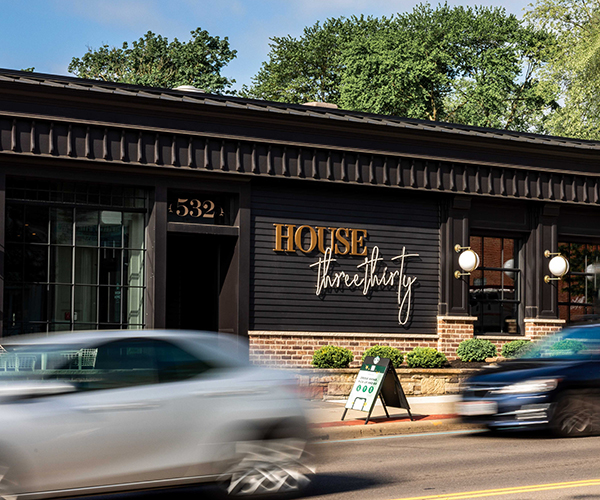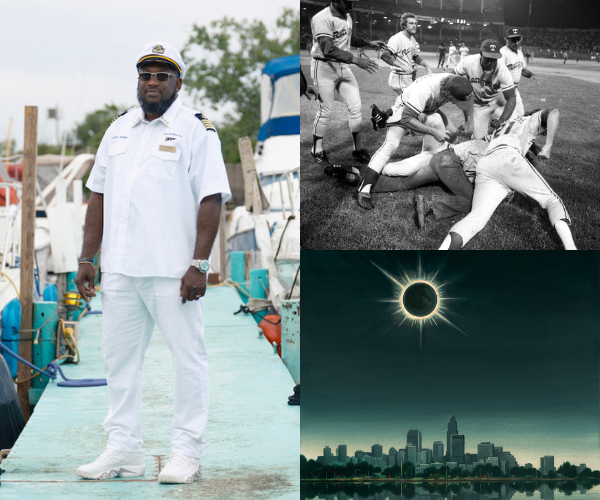This is not what I expected.
Kim Vargas is walking toward me in Harvard Square. She’s tiny — thin and only about 5 feet 3 inches tall — with a mass of long, almost-black hair. She’s wearing a camouflage cap and matching skirt that nearly hits the ground — and a happy, open expression on her face that contrasts severely with the militant getup. She gives the impression of being both tough and naïve, street-smart and sheltered.
Kim is only the second student from the Cleveland Municipal School District in 20 years to attend Harvard University. She is poor, the daughter of parents from Puerto Rico. Her mom drove her to Cambridge as a freshman in a van they’d rented for the trip.
So what I’m expecting to find is a girl who made it to Harvard, then struggled to fit in for the next four years with the prep-school kids and wealthy international students.
It is true that she didn’t fit the mold.
Especially at first, Kim’s sense of style was so impaired that one of her roommates lined up all of her shoes and all of her handbags, then asked Kim to pick a pair that could be worn together.
“That’s the only purse that can’t go with those shoes,” the frustrated roommate sighed after Kim made her choice.
Another friend climbed into one of Kim’s sweaters with her — simply to prove that all of her clothes were much, much too big for Kim’s petite frame. (Kim jokingly concedes that, in order to find a husband someday, she’ll have to ditch some of her extra-large clothing.)
That wasn’t the only way Kim was different. Because high school was relatively easy for her, she never really learned how to study. “I was all messed up,” she says. “I couldn’t read a chemistry book for more than 25 minutes. I thought I had failed every class.”
In reality, her worst grade was a C, but, at Harvard, that may as well be failing. “Any other student would die if they thought they had a C,” she adds. Two more semesters of “bad grades” followed — until Kim found a major she was passionate about.
Her SAT score — a 1370 — is below the 1500 that she says is more or less an admissions prerequisite — a fact that did not go unnoticed by other students. “I mentioned it and they were like, ‘Really, how did you get in here?’ After that, I learned not to mention it,” Kim says.
Then there’s her religious faith. The walls of her dorm room are covered with scripture, either that she wrote out herself or were sent to her by her mother. The parties thrown by Harvard fraternities and “Finals Clubs” are “where you go to get drunk and have sex,” she says. She’s not into that.
But ask Kim how she rates her Harvard experience and she gives it, on a scale of 1 to 10, an 11.
Kim says she was able to fit in because of the accepting social climate on campus. “It’s Harvard,” she laughs. “They’re all nerds. All of us.”
Those who know Kim, however, attribute her happiness not to her surroundings, but to her independent spirit. “I think Kim has a sort of basic integrity that is not subject to the whims of those around her or society,” says Brad Mahon, a graduate student who supervised Kim at her job in the psychology lab. “It’s one of the most difficult ways to live when you’re young and part of this community.”
Kim remembers the moment she stopped caring what others thought about her. She was in the third grade and for some reason the kids in her class had all started wearing their shirts inside out. “I just saw how stupid it was,” she says. And she thought to herself, If they’re making fun of me, is that really a problem?
By the time she left Harvard this June, the 21-year-old had acquired a sense of style (based largely on camouflage), as well as two college campus essentials — a cell phone and an iPod. But she never really changed and, as she walked through Harvard Yard to accept her diploma in the rain, there remained one huge difference between her and nearly everyone else around her — the future.
When I attempt to delicately ask Kim her impression of the neighborhood where she was raised, she replies in her typical straightforward fashion: “If you want to say that it was a bad neighborhood, there was a guy who was shot on our street, right in front of our house, actually.”
Kim grew up on the corner of West 11th Street and Clark Avenue in a house her mother paid $15,000 for nine years ago. Divorced when she was 6, her parents both moved here from Puerto Rico. Her father, William Vargas Jr., who suffers from epilepsy, is on disability. Her mother, Maria Santana, just recently left her long-held job at a thrift store because the dust particles aggravated her sinuses, leading to pneumonia and bronchitis. She plans to find a job in a store selling new clothes.
Kim’s mother always had a plan for Kim and her older brother, Emanuel: “First is God and second is your education. Always focus on that.”
To that end, Santana and her kids attended services at the Pentecostal church near their home three or four times a week. As for education, she planned lessons for the children when they were only 2 years old, crafting little books out of construction paper where the kids practiced their numbers, letters, colors and shapes. The goal was not to get her kids into college, which Santana calls “a blessing and a half plus.” Rather, she simply relished seeing them grasp new things. “They repeat it so well. It’s beautiful.”
Both children learned to read young. At 3 1/2, Emanuel was reading the Bible in Spanish. The library became a sort of second home.
The habit stuck. By the seventh grade, Kim was going to the library by herself every day after school. She remembers discovering a book on neuropsychology, which caused her to contemplate the relationship between the brain and the mind. “How do you get from here to there?” she remembers wondering. “From tissue and cells to jumping in front of a car to save somebody’s life?”
By the eighth grade, she says she’d read everything in the library’s young adult section, so she took to alphabetizing the collections that were out of order. When she completed that, she discovered that the staff could place special orders for her. That’s how she got her hands on her first college textbook — experimental psychology. Something clicked. Oh, my God. Oh, my God, she thought. This is what I want to do.
It was a revelation that Kim would suppress for years. “I was so tired of being poor, just so sick of it that I really wanted to make like a million dollars,” she says. “I didn’t think I could do it with psychology.” One of the lowest moments, she recalls, is when her church was raising money for a family whose house burned down and her mother could only give a few dollars. Her best strategy, she thought, would be to become a doctor.
Kim says her most valuable high school experience (and also part of the reason she thinks she got into Harvard) was conducting summer research at The Cleveland Clinic through a Hathaway Brown program run by Patty Hunt, the director of student research at the prestigious East Side school. Hunt had the idea to involve Cleveland public schools kids in the research, which is how Kim joined the program.
After her first summer, her boss at the Clinic called her into her office. Kim assumed she would be fired from the volunteer position that she so enjoyed.
Instead, she was told, “We noticed you do a lot of work,” and was offered a job. “The thing was,” says Kim, “my mom wasn’t even making $7 an hour.” She ended up working at the Clinic for four summers.
When it came time to apply for college, Kim had a short list: Case Western Reserve University, The Ohio State University and Cleveland State University. It was her guidance counselor, Fran Golden, who begged Kim to set her sights higher. “It was actually very difficult, because Kim wanted to stay here where her family was,” Golden says. “She was very, very content just to go to Case. I said, ‘Kim, just do me a favor, just apply. You don’t have to go there, you may not even get in.’ ”
If Golden hadn’t stayed on her back to get the application in, Kim admits she never would have done it. But she did. And she got in, with a full scholarship.
Even with the free ride, Kim balked. As her May 1 deadline approached, Golden pressured her to visit the campus. “OK, Kim, you applied for me. I know that,” she told her. “I’m going to ask you to do me one more favor. You need to see the school.”
Kim didn’t like the idea. “Finally, I decided I had to back off,” Golden says. But she still tracked airfares to Boston every day, hoping Kim would change her mind.
On the Thursday before the last possible weekend to visit the campus, Kim walked into Golden’s office, saying she wanted to go. By then, airfare was up to $900. Hunt was able to come up with a large chunk of the money through her Hathaway Brown program and Golden covered the rest herself.
Golden gave Kim her cell phone, $200 in cash and said, “I want you to experience Harvard this weekend like every else does. Do whatever anyone else does and don’t worry about money.”
Golden had told Kim to take a taxi from the airport. At Harvard, she bought a toothbrush, a T-shirt and two little bears — one for her mother and one for Golden — with the words “Someone at Harvard loves you” printed on them. She gave back the rest of the money, with receipts for everything she’d bought.
Harvard itself surprised Kim. “They’re normal,” she told her mother on the phone. Even better, she described the atmosphere as a “persistent desire for knowledge.” Her decision was made.
Once at Harvard, Kim continued with her plan to become a doctor. After a year and a half of bad grades, she admitted to herself that “she wasn’t passionate about it” and switched her major to the field that had so intrigued her starting in grade school — psychology. Her grades immediately improved.
About the same time, something else changed for Kim: her attitude toward money. The summer after her sophomore year, she and her family traveled to Puerto Rico for her great-grandmother’s funeral. “It felt strangely like home,” she says. Kim told her mother she had to stay longer and arranged to spend an extra two weeks with her aunt, whom she barely knew, in a small house about 15 minutes outside of San Juan.
There, she shared a bedroom with her aunt and her aunt’s daughter-in-law’s cousin, spent her days cooking and cleaning, and learned a valuable lesson by observing her extended family.
During the day, they worked hard. At night, they sat around telling stories and laughing on the porch. There was something about their demeanor that Kim can only describe as free. “They’re dirt-poor and they’re happy,” Kim says. “They’re definitely happy. You can’t say they’re not.”
Back at Harvard, things continued to click as Kim got a job working in the psychology lab, where her supervisor, Brad Mahon, says she’s the only one of six assistants he’s hired in the last two years who ended up staying. “It’d be hard for me to sing her praises too much,” he says. “If I had two more Kims, I’d probably finish my Ph.D. in a year.”
According to the terms of her work-study agreement, Kim could work up to 20 hours a week and be paid for it. By halfway through the last semester, however, she had hit her ceiling for hours allowed. Mahon says he encouraged Kim to take some time off. “She didn’t really say anything,” he reports. “But then she showed up again … kept coming in and working 15 or 20 hours a week.” Of all the time Kim spent working at the lab in the past two years, he estimates she’ll be paid for about half of it.
After Kim and I meet for dinner in Harvard Square, we walk back to her dorm room — actually a private suite with two rooms and a bath. In the second, smaller room, she’s hung a hammock beneath glow-in-the-dark stars. She sleeps here about half the time and in her bed the other half, below a note she posted that says, “Happiness is pointless.” Especially next to all the cheery Bible verses hung up, it’s jarring.
“The happiness most people are looking for is really not,” she explains, mentioning careers and money. With this, Kim brings up one of her classes — positive psychology. When she talks about herself, Kim is low-key and quiet. When others praise her in her company, she actually stares at the floor and chews her cuticles. But when she talks about ideas, she is animated, walking across the room, unable to sit still.
Things that most people think will make them happy do result in a “sudden peak,” she explains, but their happiness level soon returns to its base level. The goal is to raise your baseline. How? “By changing your mind-set, being a merit-finder, finding the good stuff.” Mindful people, she adds, “teach themselves to be very aware of the things around them. They take in everything.”
Kim then mentions how she read something in a textbook that confirmed her personal approach to happiness. “I came up with a Bible verse that means the exact same thing,” she says. “Hah, hah,” she adds cheekily. “God thought of it first.”
The next day, we meet Kim’s friends for lunch in a sunny yellow dining hall and I inquire about their future plans. Shawna’s going to law school. Frank’s going to med school. Tazneen is going to study at the University of Cambridge for a year. Janet’s going to look for a job in New York City. Mary’s going to grad school.
Kim’s going back to Cleveland. Her plan is to live at home and get a job working in a psychology lab.
Kim thinks that, in a few years, she’ll apply to work on a doctorate in psychology at Case, but she’s not entirely sure. “I haven’t thought that far ahead,” she says.
This is exactly what concerns Kim’s best friend from Harvard.
“I’d really like to see her go back to school,” says Katie Nishimura, sitting on a bench in Harvard Yard on a warm spring day. “It almost worries me that she’s just going to end up working somewhere.”
Kim’s brother, Emanuel, who just graduated from The Ohio State University with degrees in computer science and engineering, plans to move to Bethesda, Md., to take a job with Lockheed Martin. For his field, Cleveland didn’t present enough options, but for Kim’s, he doesn’t think staying close to home will be a disadvantage. At any rate, he knows that moving permanently away from their mother isn’t an option for Kim. “The thought never really crossed her mind,” he says.
But Emanuel does say that it’s critical for Kim to eventually go back to school. “I want her to succeed,” he says, “I don’t want to see her held back.”
Kim’s mother wants her daughter to succeed, too — but close to home. Here’s something you won’t hear from the average Harvard mom: “If she moves, I would go with her. I don’t want to stay here all by myself again. It was hard, very hard. I would find a job cleaning or whatever.”
So while her classmates’ parents are subsidizing first apartments in New York City or paying for graduate studies, Kim intends to be the one helping others. Her first priority is to make sure her mother doesn’t have to work. As she expects to earn about $15 an hour working at a lab (more than twice what her mother bought a house and raised two kids on), she thinks she’ll have more than enough money to accomplish her goal. She also plans to send money to her relatives in Puerto Rico.
“It’ll be good,” she says, nodding her head softly. “It’ll be good.”
Maybe you’re thinking Kim’s not making the best use of her education, that she could go further, be a bigger success more quickly.
That’s OK, because, without meaning any offense, Kim doesn’t really much care what you — or anyone else — think.



